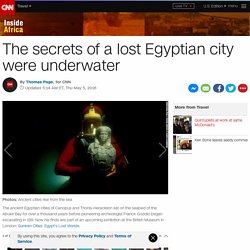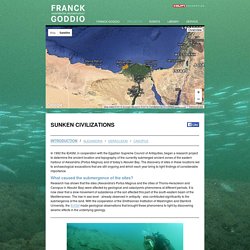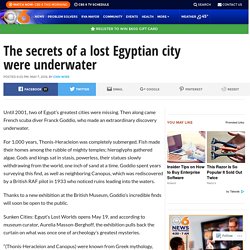

Sunken cities reveal secrets of Ancient Egypt. For 1,000 years, Thonis-Heracleion was completely submerged.

Fish made their homes among the rubble of mighty temples; hieroglyphs gathered algae. Gods and kings sat in stasis, powerless, their statues slowly withdrawing from the world, one inch of sand at a time. Goddio spent years surveying this find, as well as neighboring Canopus, which was rediscovered by a British RAF pilot in 1933 who noticed ruins leading into the waters. Thanks to a new exhibition at the British Museum, Goddio's incredible finds will soon be open to the public. Sunken Cities: Egypt's Lost Worlds opens May 19, and according to museum curator, Aurelia Masson-Berghoff, the exhibition pulls back the curtain on what was once one of archeology's greatest mysteries.
"(Thonis-Heracleion and Canopus) were known from Greek mythology, Greek historians and Egyptian decrees, and now we know where they were. " Why did they sink? Gods of yester-millennium Also worth noting is what Goddio's team left on the seabed. Ancient Egypt’s perfectly preserved underwater cities, and how they were discovered. Ten thousand dead – a conservative estimate at best.

Three million internally displaced. Twenty million in need of aid. Two hundred thousand besieged for over a year. Thirty-four ballistic missiles fired into Saudi Arabia. More than 140 mourners killed in a double-tap strike on a funeral. The British government would probably prefer to draw attention to the money being spent on aid in Yemen – £37m extra, according to figures released by the Department for International Development in September – rather than the £3.3bn worth of arms that the UK licensed for sale to Saudi Arabia in the first year of the kingdom’s bombing campaign against one of the poorest nations in the Middle East.
Yet, on the ground, the numbers are meaningless. The object of that loathing can change in the space of a few hundred metres. “We hate them. This promotion of hatred, creating what are likely to be irreversible divisions, is necessary for the war’s belligerents in order to incite tens of thousands to fight. Forums : The News Room : Sunken City Holds A Wealth Of Archaeological Treasures. Lost cities #6: how Thonis-Heracleion resurfaced after 1,000 years under water. He stood for centuries at the very edge of ancient Egypt, gazing down imperiously upon the trading ships as they blew in from the Mediterranean.

His name was Hapy: god of fertility, lord of the river, life-giving steward of its floods. And, on his plinth at the western mouth of the Nile, a massive red granite gatekeeper to one of the greatest port cities on earth. Until one day, probably towards the end of the second century BC, there was a tremor and the ground began to churn and liquefy at Hapy’s feet. He wobbled, lurched, and then six tonnes of intricately carved stonework crashed into the sea. Franck Goddio: Projects: Sunken civilizations: Introduction. In 1992 the IEASM, in cooperation with the Egyptian Supreme Council of Antiquities, began a research project to determine the ancient location and topography of the currently submerged ancient zones of the eastern harbour of Alexandria (Portus Magnus) and of today’s Aboukir Bay.

The discovery of sites in these locations led to archaeological excavations that are still ongoing and which each year bring to light findings of considerable importance. What caused the submergence of the sites? Research has shown that the sites (Alexandria's Portus Magnus and the cities of Thonis-Heracleion and Canopus in Aboukir Bay) were affected by geological and cataclysmic phenomena at different periods. Sunken Ancient City of Heracleion. The secrets of a lost Egyptian city were underwater.
Until 2001, two of Egypt’s greatest cities were missing.

Then along came French scuba diver Franck Goddio, who made an extraordinary discovery underwater. For 1,000 years, Thonis-Heracleion was completely submerged. Fish made their homes among the rubble of mighty temples; hieroglyphs gathered algae. Gods and kings sat in stasis, powerless, their statues slowly withdrawing from the world, one inch of sand at a time. Goddio spent years surveying this find, as well as neighboring Canopus, which was rediscovered by a British RAF pilot in 1933 who noticed ruins leading into the waters. Thanks to a new exhibition at the British Museum, Goddio’s incredible finds will soon be open to the public. Sunken Cities: Egypt’s Lost Worlds opens May 19, and according to museum curator, Aurelia Masson-Berghoff, the exhibition pulls back the curtain on what was once one of archeology’s greatest mysteries.
Why did they sink? Gods of yester-millennium Also worth noting is what Goddio’s team left on the seabed. Heracleion Photos: Lost Egyptian City Revealed After 1,200 Years Under Sea. It is a city shrouded in myth, swallowed by the Mediterranean Sea and buried in sand and mud for more than 1,200 years.

But now archeologists are unearthing the mysteries of Heracleion, uncovering amazingly well-preserved artifacts that tell the story of a vibrant classical-era port. Known as Heracleion to the ancient Greeks and Thonis to the ancient Eygptians, the city was rediscovered in 2000 by French underwater archaeologist Dr. Franck Goddio and a team from the European Institute for Underwater Acheology (IEASM) after a four-year geophysical survey.